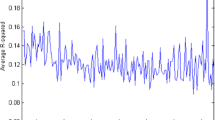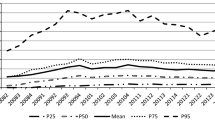Abstract
We assess the relation between asset reliability and security prices. Concerns about asset reliability are increasing with the move to fair value accounting in general purpose financial reports. We provide pertinent evidence from credit markets. A key benefit of using credit market data to explore the capital market implications of asset reliability is the theoretical basis of Duffie and Lando (Econometrica 69(3):633–664, 2001). They show that asset reliability (measurement) concerns should be concentrated in short-term credit spreads. Thus a focus on credit term structure can facilitate a cleaner identification of the impact of asset reliability on security prices. We find that asset reliability issues, attributable to SFAS 157 disclosures of Level 2 and, especially, Level 3 financial assets for a set of US financial institutions over the period of August 2007 to March 2009, are a significant determinant of short-term credit spreads and the shape of the general credit term structure. Our findings are robust to a variety of control variables and research design choices.



Similar content being viewed by others
References
Calomiris, C. W., & Wilson, B. (2004). Bank capital and portfolio management: The 1930 “capital crunch” and the scramble to shed risk. Journal of Business, 77, 421–455.
Chacko, G. (2005). Liquidity risk in the corporate bond markets. working paper. Harvard Business School.
Covitz, D., & Downing, C. (2007). Liquidity or credit risk? The determinants of very short-term credit yield spreads. Journal of Finance, 62(5), 2303–2328.
Crosbie, P., & Bohn, J. (2003). Modelling default risk. White paper, Moody’s/KMV.
Downing, C., Underwood, S., Xing, Y. (2005). Is liquidity risk priced in the corporate bond market? Working paper. Rice University.
Duffie, D., & Lando, D. (2001). Term-structures of credit spreads with incomplete accounting information. Econometrica, 69(3), 633–664.
Duffie, D., & Singleton, K. (1999). Modelling term-structures of defaultable bonds. Review of Financial Studies, 12, 687–720.
Elton, E., Gruber, M., Agrawal, D., & Mann, C. (2001). Explaining the rate spreads on corporate bonds. Journal of Finance, 56, 247–277.
Eom, Y., Helwege, J., & Huang, J. (2004). Structural models of corporate bond pricing: An empirical analysis. Review of Financial Studies, 17, 499–544.
Finger, C., Finkelstein, V., Lardy, J., Pan, G., Ta, T., & Tierney, T. (2002). CreditGrades: Technical Document. Research paper at RiskMetrics Group.
Giesecke, K. (2006). Default and information. Journal of Economic Dynamics and Control, 30, 2281–2303.
Helwege, J., & Turner, C. M. (1999). The slope of the credit yield curve for speculative grade issuers. Journal of Finance, 54(5), 1869–1884.
Holthausen, R., & Watts, R. (2001). The relevance of the value relevance literature for financial accounting standard setting. Journal of Accounting and Economics, 31, 3–75.
Huang, J., & Huang, M. (2002). How much of the corporate-treasury yield spread is due to credit risk? A new calibration approach, working paper. Stanford University.
Jarrow, R. A., Lando, D., & Turnbull, S. (1997). A Markov Model for the term-structure of credit spreads. Review of Financial Studies, 10, 481–523.
Kolev, K. (2011). Do investors perceive narking-to-model as marking-to-myth? Early evidence from FAS 157 disclosures, working paper. NYU.
Lambert, R. A. (1996). Financial reporting research and standard setting, Unpublished working paper. University of Pennsylvania.
Li, F. (2006). Annual report readability, current earnings, and earnings persistence. Ross school of business paper no. 1028.
Longstaff, F., Mithal, S., & Neis, E. (2005). Corporate yield spreads: Default risk or liquidity? New evidence from the credit default swaps market. Journal of Finance, 60, 2213–2253.
Merton, R. C. (1974). On the pricing of corporate debt: The risk structure of interest rates. Journal of Finance, 2, 449–470.
Richardson, S. A., Sloan, R. G., Soliman, M. T., & Tuna, I. (2005). Accrual reliability, earnings persistence and stock prices. Journal of Accounting and Economics, 39, 437–485.
Sloan, R. G. (1996). Do stock prices fully reflect information in accruals and cash flows about future earnings? The Accounting Review, 71, 289–315.
Song, C. J., Thomas, W. B., & Yi, H. (2010). Value relevance of FAS No. 157 fair value hierarchy information and the impact of corporate governance mechanisms. The Accounting Review, 85, 1375–1410.
Watts, R. L. (2003). Conservatism in accounting part I: Explanations and implications. Accounting Horizons, 17, 207–221.
Yu, F. (2005). Accounting transparency and the term-structure of credit spreads. Journal of Financial Economics, 75, 53–84.
Zhou, C. (2001). The term-structure of credit spreads with jump risk. Journal of Banking & Finance, 25, 2015–2040.
Acknowledgments
We thank seminar participants at Bocconi University, London Business School, London School of Economics, University of Sydney, and the MEAFA Conference. We also thank Darrell Duffie, Paul Dunmore, John Hand, Anya Kleymenova, S. P. Kothari, Francis Longstaff, Doron Nissim (editor), Stephen Penman, Stephen Schaefer, Lakshmanan Shivakumar, Kari Sigurdsson, Regina Wittenberg-Moerman, Fan Yu, Bin Zeng, and two anonymous referees for their useful comments. We are grateful to Feng Li for making available his measures of financial reporting transparency. We also thank Jing Zhang at Moody’s Analytics for providing us with EDF data. An earlier version of this paper was titled “Asset measurement uncertainty and credit term structure.” The views expressed here are those of the authors and do not reflect the views of Citadel LLC, its affiliates, or employees.
Author information
Authors and Affiliations
Corresponding author
Appendices
Appendix 1: Variable definitions
CDS1Y/CDS5Y: The ratio of the spread on a 1-year CDS contract to the spread on a 5-year CDS contract. It measures the relative steepness of the front end of a given firm’s credit term structure.
CDS5Y/CDS10Y: The ratio of the spread on a five-year CDS contract to the spread on a 10-year CDS contract. It measures the relative steepness of the middle portion of a given firm’s credit term structure.
MCAP: The log of market capitalization.
MLEV: Market leverage, measured as the ratio of the sum of short-term and long-term debt to market capitalization.
DEPTH: The number of dealers providing quotes for the 5-year CDS contract as reported in the MarkIt database.
REFINANCE: The log ratio of short-term debt to long-term debt. It is a measure of companies’ need to access debt markets in the near term.
L23/TA: The ratio of financial assets marked to market as either Level 2 or Level 3 assets under FAS157 relative to total assets.
L2(3)/TA: The ratio of financial assets marked to market as Level 2 (3) assets under FAS157 relative to total assets.
L23/FA: The ratio of financial assets marked to market as either Level 2 or Level 3 assets under FAS157 relative to total financial assets.
L2(3)/FA: The ratio of financial assets marked to market as Level 2 (3) assets under FAS157 relative to total financial assets.
CDSJY: The quoted spread for a given firm’s credit default swap contract for J year maturity, where J = 1, 3, 5 or 10.
σ Assets : Our proxy for jump risk. It is the option-implied volatility of a liquid out-of-the-money put option with maturity of 90 days.
All variables are measured at the start of each month over the period August 2007 through March 2009. We stop our analysis at March 2009 due to the changes in the CDS market at that time.
We require at least three dealer quotes for a firm-month observation to be retained. We remove firm-month records where a given variable is in the extreme percentiles (i.e., delete top and bottom 1 percent).
We use US dollar-denominated CDS contracts with a modified restructuring (MR) clause.
Appendix 2: Sample firms
Banks | |
COUNTRYWIDE FINANCIAL CORP | POPULAR INC |
FANNIE MAE | RADIAN GROUP INC |
FEDERAL AGRICULTURE MT | REGIONS FINANCIAL CORP |
FEDERAL HOME LOAN MORT | SUNTRUST BANKS INC |
KEYCORP | U S BANCORP |
MGIC INVESTMENT CORP/W | WACHOVIA CORP |
NATIONAL CITY CORP | WELLS FARGO & CO |
PMI GROUP INC | WMI HOLDINGS CORP |
Diversified financials | |
AFFILIATED MANAGERS GR | GOLDMAN SACHS GROUP IN |
AMERICAN EXPRESS CO | JANUS CAPITAL GROUP IN |
AMERIPRISE FINANCIAL I | JPMORGAN CHASE & CO |
BANK OF AMERICA CORP | LEGG MASON INC |
BEAR STEARNS COMPANIES INC. | LEHMAN BROTHERS HOLDINGS INC |
CAPITAL ONE FINANCIAL | MERRILL LYNCH & CO INC |
CIT GROUP INC | MORGAN STANLEY |
DISCOVER FINANCIAL SVC | SCHWAB (CHARLES) CORP |
E TRADE FINANCIAL CORP | SLM CORP |
FRANKLIN RESOURCES INC | STATE STREET CORP |
Insurance | |
AFLAC INC | LINCOLN NATIONAL CORP |
ALLSTATE CORP | LOEWS CORP |
AMBAC FINANCIAL GROUP | MARKEL CORP |
AMERICAN FINANCIAL GROUP INC. | MARSH & MCLENNAN COS |
AMERICAN INTERNATIONAL GROUP | MBIA INC |
AON PLC | METLIFE INC |
ARCH CAPITAL GROUP LTD | ODYSSEY RE HOLDINGS CO |
ASSURANT INC | PROGRESSIVE CORP-OHIO |
BERKLEY (W R) CORP | PRUDENTIAL FINANCIAL I |
BERKSHIRE HATHAWAY | REINSURANCE GROUP AMER INC. |
CHUBB CORP | RENAISSANCERE HOLDINGS |
CNA FINANCIAL CORP | SAFECO CORP |
GENWORTH FINANCIAL INC | TORCHMARK CORP |
HARTFORD FINANCIAL SER | TRAVELERS COS INC |
HORACE MANN EDUCATORS CORP | UNUM GROUP |
KEMPER CORP/DE | |
Real estate | |
AVALONBAY COMMUNITIES | KIMCO REALTY CORP |
BOSTON PROPERTIES INC | MACK-CALI REALTY CORP |
CAMDEN PROPERTY TRUST | NATIONWIDE HEALTH PPTY |
DDR CORP | PROLOGIS INC |
DUKE REALTY CORP | RAYONIER INC |
FIRST INDL REALTY TRUS | SIMON PROPERTY GROUP I |
GENERAL GROWTH PPTYS I | UDR INC |
HCP INC | VORNADO REALTY TRUST |
HEALTH CARE REIT INC | WASHINGTON REIT |
ISTAR FINANCIAL INC | WEINGARTEN REALTY INVS |
Rights and permissions
About this article
Cite this article
Arora, N., Richardson, S. & Tuna, İ. Asset reliability and security prices: evidence from credit markets. Rev Account Stud 19, 363–395 (2014). https://doi.org/10.1007/s11142-013-9254-7
Published:
Issue Date:
DOI: https://doi.org/10.1007/s11142-013-9254-7




